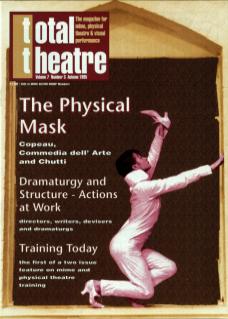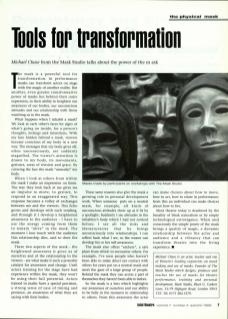The mask is a powerful tool for transformation. In performance, masks can transform actors on stage with the magic of another reality. But another, even greater transformative power of masks lies behind their outer expression, in their ability to heighten our awareness of our bodies, our unconscious attitudes and our relationship with those watching us in the mask.
What happens when I inhabit a mask? We look at each other's faces for signs of what's going on inside, for a person's thoughts, feelings and intentions. With my face hidden behind a mask, viewers become conscious of my body in a new way. The messages that my body gives off, often unconsciously, are suddenly magnified. The viewer's attention is drawn to my body, its movements, gestures, areas of tension and grace. By covering the face the mask ‘unmasks’ my body.
When I look at others from within the mask I make an impression on them.
The way they look back at me gives me an impulse to move, to gesture, to respond in an exaggerated way. This response becomes a volley of exchanges between me and the viewers. This Echo grows and develops with each sending, and through it I develop a heightened awareness to the audience. I have to use the energy coming from them to remain ‘alive’ in the mask. The moment I lose touch with the audience this relationship dies, and so does the mask.
These two aspects of the mask – the heightened awareness it gives us of ourselves and of the relationship to the viewers – are what make it such a powerful catalyst for awareness and change. Until actors training for the stage have had experience within the mask, they won't be using their full potential. Actors trained in masks have a special precision, a strong sense of ease of timing and presence, an awareness of what they are saying with their bodies.
These same reasons also give the mask a growing role in personal development work. When someone puts on a neutral mask, for example, all kinds of unconscious attitudes show up as if lit by a spotlight. Suddenly I see attitudes in the inhabitor's body which I had not noticed before; I see all the ticks and idiosyncrasies that he brings unconsciously into relationships. I can reflect back what I see, so the wearer can develop his or her self-awareness.
The mask also offers ‘asylum’, a safe place from which to encounter others. For example, I've seen people who haven't been able to make direct eye contact with others for years put on a neutral mask and meet the gaze of a large group of people. Behind the mask they can access a part of themselves they haven't been able to before.
So the mask is a lens which highlights our awareness of ourselves and our ability to be fully in the moment in relationship to others. From this awareness the actor can make choices about how to move, how to act, how to relate in performance; from this an individual can make choices about how to live.
Most theatre today is deadened by the banality of bleak naturalism or by empty technological extravagance. When used consciously the simple power of the mask brings a quality of magic, a dynamic relationship between the actor and audience and a vibrancy that can transform theatre into the living experience.
Michael Chase is an actor, teacher and one of Britain's leading exponents on mask making and use of masks. He is founder of The Mask Studio, which designs, produces and teaches the use of masks for theatre performance, training and personal development.

